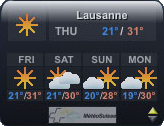Are widgets the next revolution for television? At the CES you certainly couldn't escape them. The word 'widget' is a general purpose English language noun used for many things, rather like 'thingamajig' or 'machin' in French. On our personal computer screens we are quite used to seeing what are called 'widgets' there. They are the animations cut into the screen giving, for example, the latest news or a clock. The PC has usually gone to a website somewhere to find the information it needs for our widget display.
| The hottest topic at this year's CES was undoubtedly the use of one kind of 'widget' to enhance the television viewing experience. It connects up the TV and the web. You buy a special new TV set-top box or you buy a new digital TV with the widget feature built in. You connect the TV or box to a broadband web connection. When you switch the TV on, and press the button on the handset marked 'widgets', the thing automatically goes to the Yahoo website. When it gets there it finds the so called 'Widget Gallery', which it brings back and displays at the bottom of your TV screen. The Gallery gives you a list of the multimedia services that are available, courtesy of the Yahoo gateway. |  Weather widget |
The services can be connected or unconnected with a TV programme, and can contain text, animations, movies, etc - all the things you expect from a web site, but with a difference. This time they have been laid out on the screen so that any slob can read them from way back in the room, sitting on the settee with his beer and popcorn. Anyone can make a widget, provided they follow the Yahoo 'Widget developers' kit', and upload it to Yahoo. Anyone can offer the viewer their multimedia content to superimpose on the TV picture. Many companies have already started providing Widgets, including (as far as the author could tell) the biggest French national broadcaster TF1. So this technology seems to be headed for Europe too.
Widget wars
This development is spearheaded by two companies, Yahoo and Intel. Yahoo, in the process of slipping down the popularity scale, may now have the means to rise again, and match its great rival, Google. But, don't worry - live will not be so simple. The big companies, Google and Apple, are bound to respond to this development in a true spirit of cooperation by creating their own incompatible technology. Yahoo will probably not want to make their system an 'open standard' so we may be faced with some years of 'widget wars' between competing implementations.
Can we be sure this will be a success? What the viewer sees will be something like the 'interactive TV experience' we have been trying to make popular in Europe for the last 12 years. Do people really want multimedia splattered over their screen when they are trying to watch a programme? Interactive multimedia has not been as successful as we thought it would be in Europe. Even where available, it is still a 'niche' service. Why should things be different now? Time will tell.
